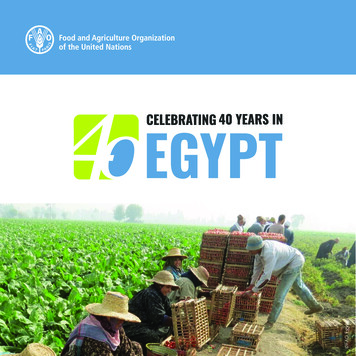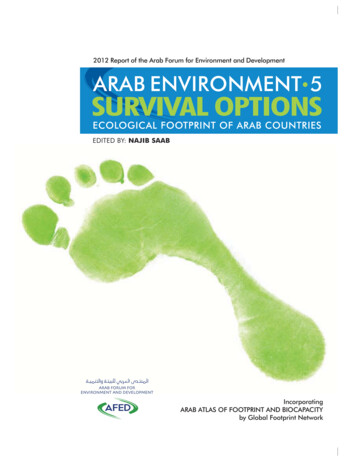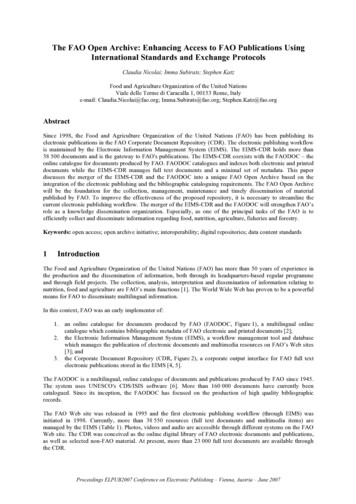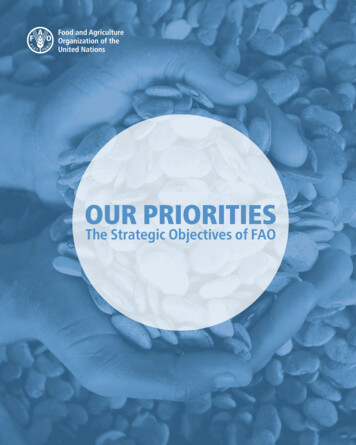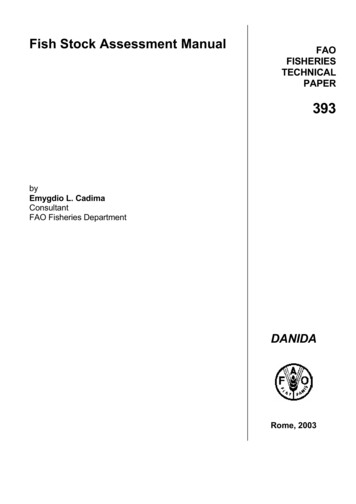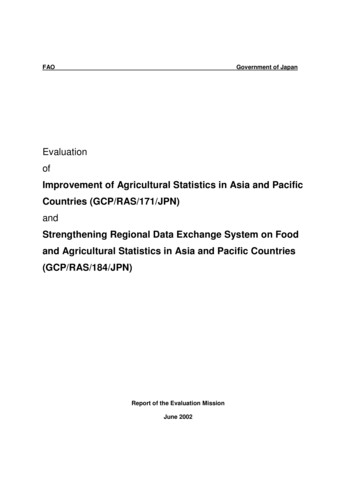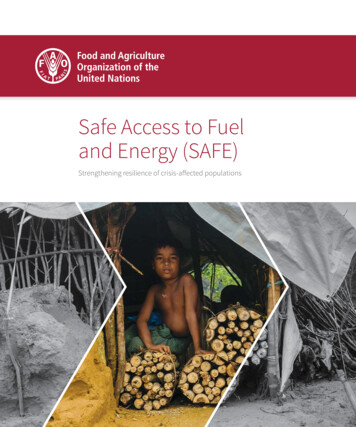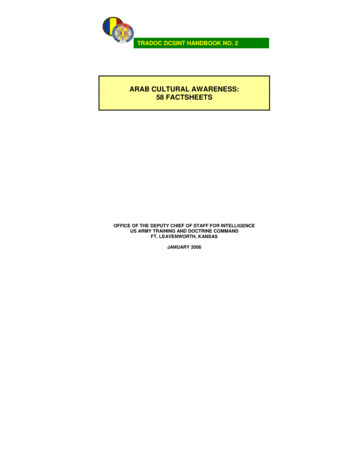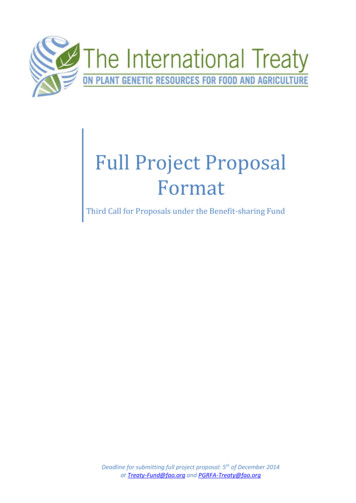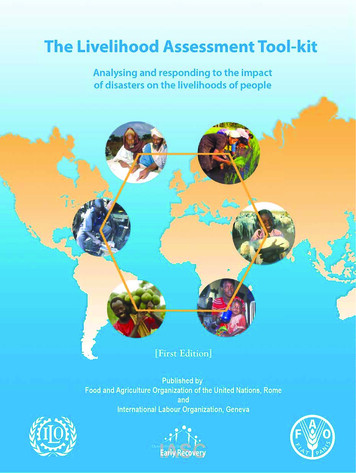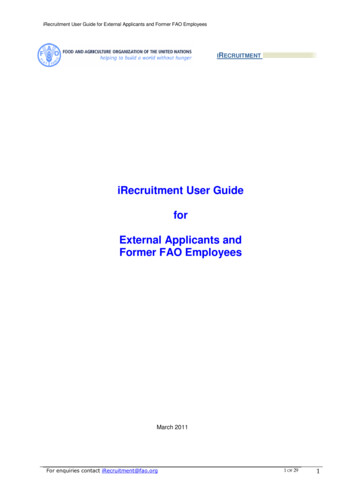
Transcription
World Food ProgrammeSPECIAL REPORTFAO/WFP CROP AND FOOD SECURITY ASSESSMENTMISSION TO THE SYRIAN ARAB REPUBLIC5 September 2019Photographs: FAO/Monika Tothova/Mamadou Niang and WFP/Cinzia Monetta.
This report has been prepared by Monika Tothova and Mamadou Niang (FAO) and Eliana Favari, Cinzia Monetta,Gehan Alhossiny, Siddharth Krishnaswamy, Rama Suleiman, Kenneth Anyanzo, Ghaith Fadel and Jan Michiels(WFP) under the responsibility of the FAO and WFP secretariats with information from official and other sources.Support during the field Mission from Haya AbouAssaf, AbdulBasset Khalil, Jalal AlHamoud, Luca Innocente,Swithun Goodbody, Maher Khalouf, Jihad AlMukdad, Fadi AlHamoud, Khaled Omar, Abdulhakim Dewani,Sulaiman Karazon, Moammar Alhosaeen, Aya Hazem, Yaser Ali, Oula Mohamad, Abdallah Almomani, AmjadAlhamada, and Bashar Akkad is gratefully acknowledged. Since conditions may change rapidly, please contactthe undersigned for further information if required.Mario ZappacostaSenior Economist, EST-GIEWSTrade and Markets Division, FAOE-mail: giews1@fao.orgMuhannad HadiRegional Director, Middle East, North Africa,Central Asia and Eastern Europe, WFPE-mail: Muhannad.Hadi@wfp.orgPlease note that this Special Report is also available on the Internet as part of the FAO World Wide Webwww.fao.org at the following URL address: http://www.fao.org/giews/The Global Information and Early Warning System on Food and Agriculture (GIEWS) has set up a mailing list todisseminate its reports. To subscribe, submit the Registration Form on the following link:http://newsletters.fao.org/k/Fao/trade and markets english giews world
SPECIAL REPORTFAO/WFP CROP AND FOOD SECURITY ASSESSMENTMISSION TO THE SYRIAN ARAB REPUBLIC5 September 2019FOOD AND AGRICULTURE ORGANIZATION OF THE UNITED NATIONSWORLD FOOD PROGRAMMERome, 2019
Required citation:FAO. 2019. Special Report - FAO/WFP Crop and Food Security Assessment Mission to the Syrian ArabRepublic. Rome.The designations employed and the presentation of material in this information product do not imply theexpression of any opinion whatsoever on the part of the Food and Agriculture Organization of the UnitedNations (FAO) concerning the legal or development status of any country, territory, city or area or of itsauthorities, or concerning the delimitation of its frontiers or boundaries. The mention of specific companiesor products of manufacturers, whether or not these have been patented, does not imply that these have beenendorsed or recommended by FAO in preference to others of a similar nature that are not mentioned.The views expressed in this information product are those of the author(s) and do not necessarily reflect theviews or policies of FAO.ISBN 978-92-5-131773-0 FAO, 2019Some rights reserved. This work is made available under the Creative Commons Attribution-NonCommercialShareAlike 3.0 IGO licence (CC BY-NC-SA 3.0 IGO; go/legalcode).Under the terms of this licence, this work may be copied, redistributed and adapted for non-commercialpurposes, provided that the work is appropriately cited. In any use of this work, there should be no suggestionthat FAO endorses any specific organization, products or services. The use of the FAO logo is not permitted.If the work is adapted, then it must be licensed under the same or equivalent Creative Commons license. Ifa translation of this work is created, it must include the following disclaimer along with the required citation:This translation was not created by the Food and Agriculture Organization of the United Nations (FAO). FAOis not responsible for the content or accuracy of this translation. The original [Language] edition shall be theauthoritative edition.Disputes arising under the licence that cannot be settled amicably will be resolved by mediation andarbitration as described in Article 8 of the licence except as otherwise provided herein. The applicablemediation rules will be the mediation rules of the World Intellectual Property ules and any arbitration will be in accordance with the ArbitrationRules of the United Nations Commission on International Trade Law (UNCITRAL).Third-party materials. Users wishing to reuse material from this work that is attributed to a third party, suchas tables, figures or images, are responsible for determining whether permission is needed for that reuseand for obtaining permission from the copyright holder. The risk of claims resulting from infringement of anythird-party-owned component in the work rests solely with the user.Sales, rights and licensing. FAO information products are available on the FAO website(www.fao.org/publications) and can be purchased through publications-sales@fao.org. Requests forcommercial use should be submitted via: www.fao.org/contact-us/licence-request. Queries regarding rightsand licensing should be submitted to: copyright@fao.org.
iiiCONTENTSPageACRONYMS AND ABBREVIATIONS . vHIGHLIGHTS .viINTRODUCTION . 1ASSESSMENT METHODOLOGY . 1BACKGROUND AND SOCIO-ECONOMIC CONTEXT . 4General . 4Syrian Pound depreciation on the informal market . 4Agriculture . 6CEREAL PRODUCTION . 8Cereal area, 2018/19 . 8Factors affecting yields . 9Weather . 9Irrigation .13Inputs .14Seed .14Fertilizers .15Fuel .16Crop-protection materials .16Mechanization.16Labour.16Pests and diseases .17Farm access and movement of farmers and produce .17Cereal production, 2018/19 .17Yields .17Production.18OTHER CROPS .20Food legumes .20Potatoes .21Vegetables .21Fruit trees .22Herbs .22Industrial crops .23Sugar beet .23Cotton .23Tobacco .23POST-HARVEST AND OTHER PROBLEMS.24LIVESTOCK .25Livestock numbers .25Animal nutrition .30Animal production .32Animal health .35LOCAL FOOD MARKET CONDITIONS .36Food prices .38Prices of cereals and agricultural commodities .41Bread .42Fuel prices - petrol .44Fuel prices - butane gas .45Livestock prices .47Terms of trade .47
ivCEREAL SUPPLY/DEMAND SITUATION .49Population .49National cereal balance sheet .49HOUSEHOLD FOOD SECURITY SITUATION.50Food security situation and trends .50Food consumption .55Quality of the diet and the long-term impact on nutrition and health .57Food coping strategies .58Livelihood trends .60Exposure to shocks and main constraints .60Livelihood coping .61Humanitarian access .62Gender overview .63Displacement and return.64Food assistance and assistance requirements in 2019 .65RECOMMENDATIONS .66Agriculture .66Food security .68ANNEX .70Photographs from the Mission .72
vACRONYMS AND UNFPAUNHCRUN-OCHAUSDWFPWoSXBy-o-yAgricultural Cooperative BankAgro-Ecological ZonesArtificial inseminationAgricultural Stress Indexbarrels per dayCamp Coordination and Camp ManagementCrop and Food Security Assessment MissionEconomic and Social Commission for Western AsiaFood and Agriculture Organization of the United NationsData programme of FAO Statistics DivisionFocus Group DiscussionsFood Security SectorFoot-and-Mouth DiseaseGross Domestic ProductGeneral Organization for FeedGeneral Organization for Remote SensingGeneral Organization for Seed MultiplicationGeneral Organization of TobaccohectareGeneral Establishment for Cereal Trade and ProcessingHard-To-ReachInternational Committee of the Red CrossInternally Displaced PersonsInternational Fund for Agricultural DevelopmentIslamic StatekilogrammeMinistry of Agriculture and Agrarian ReformMinistry of Internal Trade and Consumer ProtectionmillimetreMinistry of Water Resourcesmobile Vulnerability Analysis and Mappingpregnant and lactating womenreduced Coping Strategy IndexSyrian Arab Red CrescentSyrian PoundtonneTerms of TradeUnited NationsUnited Nations Development ProgrammeUnited Nations Population FundUnited Nations High Commissioner for RefugeesOffice for the Coordination of Humanitarian AssistanceUS DollarWorld Food ProgrammeWhole of Syriacross-borderyear-on-year
viHIGHLIGHTS Security: Although pockets of active conflict are still prevalent, much of the country is now moresecure than it has been for several years, and significant numbers of Internally Displaced Persons(IDPs) have begun to return to their homes and farms. The Ministry of Agriculture and AgrarianReform estimates that around 800 000 IDPs, mostly farmers, returned to their areas of origin in2018. Further return estimates by UN-OCHA place IDP returns at an additional 130 000 people inthe first half of 2019.Crop production: Ample and well distributed rainfall in the 2018/19 agricultural season, coupledwith improved security, resulted in a significant expansion of the area under cereals. The harvestedwheat area (1.26 million hectares) was almost double that of 2018, but it is still 25 percent belowthe pre-crisis harvested wheat area (2002-2011 average). The harvested barley area (1.34 millionhectares) increased by 73 percent from last year and is on par with the pre-crisis average. The yieldof wheat, at 1.73 tonnes/hectare, was unexceptional as high temperatures in May had an adverseeffect on grain filling, but the yield of barley, at 1.5 tonnes/hectare, was the highest for at least thelast ten years. Wheat production is estimated at 2.2 million tonnes, up from 1.2 million in 2018, butstill below the pre-crisis level of 4.1 million tonnes (2002-2011). At 2 million tonnes, up from0.4 million tonnes in 2018, barley production exceeds pre-crisis levels.Fires in standing cereal crops are not unusual near harvest time in the country, but this year, withhigh temperatures and strong winds, they were much more frequent and more intense. TheGovernment estimates that 85 000 hectares of crops were burnt this year. Many of the fires mayhave been started accidentally, but there is evidence to suggest that some were started maliciously.Main agricultural constraints for crop production: Farmers continue raising concerns abouthigh production costs, high transportation costs and lack of quality inputs. Government initiativeshave led to an increase in the availability of farm machinery, but overall availability remainsinsufficient. Some progress has been made on the rehabilitation of irrigation structures, althoughillegal drilling over the past years is likely to lower the underground water table in a year of averagerains. High rates of wastage were reported in fruit and vegetable production, constrained by lowconsumer purchasing power, the inability to export and a shortage of processing factories.Livestock: Nationally, overall livestock numbers stabilized despite a slight reduction in sheep andcattle in 2018/19, as compared to the previous year. While the prevalence of common epizooticdiseases remained relatively stable, the incidence of lumpy-skin disease increased in somelocations in 2018/19, possibly due to high temperatures and high humidity which favoured theproliferation of the insect vectors. Artificial insemination, although widespread, has often lowsuccess rates, possibly due to poor timing and lack of breeder awareness of oestrus. Feed pricesremained high, but pasture conditions improved. Prices of animals and meat generally showed anupward trend compared to 2017/18, while milk prices eased.Beekeeping, which used to be a prolific traditional industry in the country, has suffered similarproblems as other sectors during the crisis. Efforts are being made by the Government andinternational organizations to restore the sector to increase pollination as well as provide livelihoodoptions. However, concerns prevail about mortality resulting from the misuse of pesticides and lackof marketing channels for honey and bee products to guarantee viable livelihoods.Humanitarian access: The number of people residing in hard-to-reach locations continued todecline in 2018 and 2019. By October 2018 (latest date for which information is available),1.2 million people were estimated to be residing in hard-to-reach areas, down from 4.1 millionpeople in January 2017. Since April 2018, there are no longer besieged areas in the Syrian ArabRepublic. Previously besieged and hard-to-reach areas represent locations that have suffered ahigh human and economic cost, as they were exposed to heavy fighting and widespreaddestruction.Displacement: Even though decreasing from around 6.2 million in 2018, IDP numbers in the SyrianArab Republic remain staggering. The Inter-Agency Population Task Force estimated that inMay 2019, 29 percent of Syrians (5.9 million people) were currently internally displaced. Whilereturns have started taking place across central, eastern and southern parts of the country, newdisplacements, estimated at around 518 000 since May 2019 due to ongoing conflict, were beingreported in northwest Syrian Arab Republic (Hama, Idleb and Aleppo). Displacement due to conflictcontinues to be one of the main drivers of food insecurity, as IDPs tend to lose most of theirlivelihoods and productive assets by moving.Markets and trade: Access to markets has greatly improved across the Syrian Arab Republic sincethe height of the conflict (2014-2016), as key east-west and north-south supply routes have becomeaccessible and active. While internal trade is picking up, export markets remain limited/inaccessiblefor much of Syrian produce. Due to the increasing cost of transportation in 2018/19, worsening
vii consumer purchasing power and a better-than-average agricultural season, many traders are notable to sell their produce. This was particularly pronounced for typical fruit and vegetable surplusproducing areas such as Lattakia and Tartous governorates, where traders reported high levels offood waste and possibly closing their food trade businesses.Price trends: Food prices have drastically increased in the Syrian Arab Republic as a result of theconflict. The main causes of the price increase have been the limited access to land and inputs,reduced local production, damage and looting of production assets and processing plants as wellas the devaluation of the national currency. While prices had initially decreased since their peak inDecember 2016, they have been gradually increasing again over the past 12 to 14 months largelyas a result of higher fuel prices and a continuous depreciation of the Syrian Pound on the informalexchange market (the SYP has depreciated by 34 percent against the US Dollar since June 2018).Food consumption and coping: Despite an initial improving trend, households adopting negativecoping mechanisms to meet food shortages has slightly increased compared to the first semesterof 2018 ( 15 percent), without exceeding, however, the negative coping levels recorded in 2016.Households’ limited purchasing power is also reflected in the nature of food coping strategies, withmore than 50 percent of the households reported to rely on less preferred and less expensive food,46 percent reduced the number of meals and 38 percent restricted the consumption of adults toprioritize children’s food habits. Consuming less preferred and less expensive food is by far themost widely adopted food comping mechanism across the Syrian Arab Republic.Food security trends and assistance needs: The overall situation with respect to food securityhas improved compared to last year in almost all the assessed areas. The most vulnerablegovernorates of the country remain those where localized military operations are still ongoing, suchas Aleppo, Raqqa and Deir-ez-Zor. The governorate with the highest proportion of households withpoor food consumption is Raqqa. Vulnerability to food insecurity in the Syrian Arab Republicremains at worrying levels across both urban and rural areas.
-1INTRODUCTIONA joint FAO/WFP Crop and Food Security Mission (CFSAM) visited the Syrian Arab Republic between 8 Juneand 4 July 2019 to estimate crop production and to assess the country’s overall food-security situation.On arrival in the country, the international members of the CFSAM team spent three days in Damascus priorto going to the field. During that time, joined by a small number of national FAO and WFP staff, they heldmeetings with the Ministry of Agriculture and Agrarian Reform (MAAR) and several other relevant Ministriesand State bodies of the Government of the Syrian Arab Republic. The team, consisting of national andinternational staff, then spent three weeks in the field collecting data and observing the agricultural and foodsecurity situation in ten of the country’s 14 governorates. In Hama Governorate the team met national stafffrom two governorates, Raqqa and Idleb, which it was unable to visit for security reasons, to discuss thesituation in those governorates. On return to Damascus, the CFSAM team held meetings with the agriculturaldirectors of Quneitra and Sweida, the two remaining governorates that it was unable to visit. The team alsodiscussed its field findings and observations with the principal technical staff of MAAR. Prior to departure fromthe country, the Mission briefed the Minister of Agriculture and Agrarian Reform on its main findings.ASSESSMENT METHODOLOGYPrior to going to the field, the Mission held meetings in Damascus with a number of line Ministries and agenciesinvolved in aspects of agriculture, access to food, humanitarian and livelihood activities. These included MAAR,the Ministry of Water Resources (MWR), the General Establishment for Cereal Trade and Processing(Hoboob) - the State wheat-purchasing authority, the Ministry of the Environment and Local Administration,the Syrian Arab Red Crescent (SARC), the International Committee of the Red Cross (ICRC), the UN Officefor the Coordination of Humanitarian Affairs (UN-OCHA), and the office of the UN High Commissioner forRefugees (UNHCR). On its return from the field the Mission had further meetings with the General Organizationfor Remote Sensing (GORS), the Agricultural Cooperative Bank (ACB) and the Ministry of Internal Trade andConsumer Protection (MITCP).The Mission visited ten of the country’s 14 governorates1 - Aleppo, Hasakeh, Hama, Homs, Deir-ez-Zor,Lattakia, Tartous, Damascus, Rural Damascus and Dara’a. Raqqa and Idleb were considered too insecure towarrant a visit while Quneitra and Sweida were not covered for time reasons. Excluding Damascus which islargely urban and where the CFSAM team conducted meetings with WFP, FAO and MAAR, for the ten othergovernorates that it visited, the Mission members held meetings with technical staff of the agriculturedirectorates, farmers, livestock herders and breeders, traders, and households. They also inspected fields ofstanding crops, fields being harvested and cereals being threshed, and visited livestock markets and wholesalefarm-produce markets to assess price trends as an indication of supply. Locations of field visits and farmerinterviews are shown in Map 1.1In addition to agricultural directorates in 14 governorates, Al Ghab plain, a fertile depression lying in both Hama and Idlebgovernorates, has its own agricultural authority. The Mission did not visit Al Ghab for security reasons but met with theagricultural director. Where possible, data for Al Ghab are presented separately.
-2Map 1: Syrian Arab Republic - Locations of field visits and farmer interviewsSource: CFSAM, 2019.Figures for cereal areas planned, planted and harvested were provided by MAAR, and these figures werecorroborated by the agricultural directorates in the governorates that the Mission visited. Yield estimates werealso provided by MAAR and the technical staff of the agricultural directorates. These estimates were criticallyreviewed by the Mission in light of field observations, crop inspections and other available information. Muchof this additional information emanated from interviews with farmers, and included, inter alia, planting time,seed rates, the availability and use of certified seed, fertilizers and other inputs, the use or otherwise ofmachinery for farm operations, and the availability and reliability of irrigation. Other information used includedrainfall records and decadal satellite imagery showing rainfall patterns, rainfall anomalies from the long-termaverage, soil moisture stress and Agricultural Stress Index (ASI). Where deemed necessary, the yieldestimates were modified by the Mission.The Mission was assisted by a report estimating area, yield and total production of wheat and barley from theGORS using high-definition satellite imagery which is able to distinguish different crops with a reasonable levelof accuracy on the basis of their spectral characteristics. Last year, the last image was taken on 15 April 2018,shortly before the arrival of unseasonably heavy and damaging rains which resulted in lower production than
Gehan Alhossiny, Siddharth Krishnaswamy, Rama Suleiman, Kenneth Anyanzo, Ghaith Fadel and Jan Michiels (WFP) under the responsibility of the FAO and WFP secretariats with information from official and other sources. Support during the field Mission from Haya AbouAssaf, AbdulBasset Khalil, Jalal AlHamoud, Luca Innocente,
